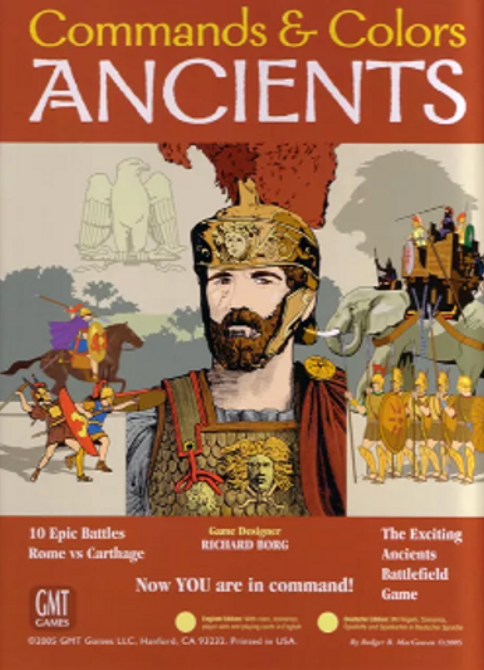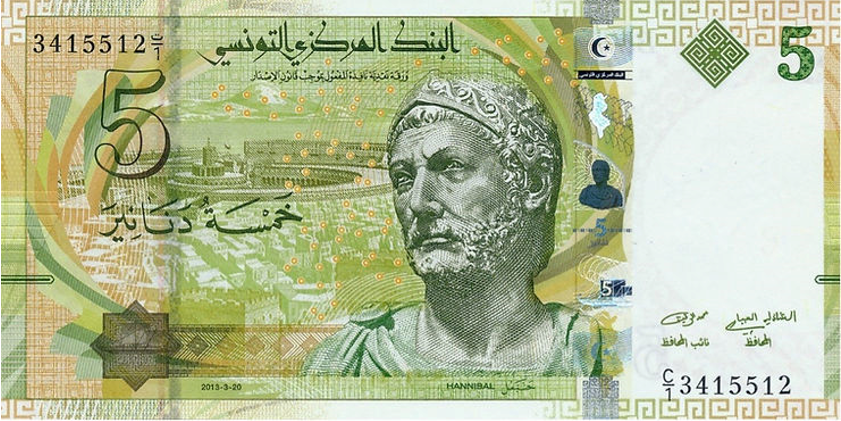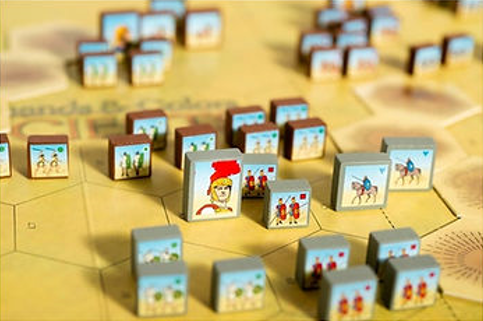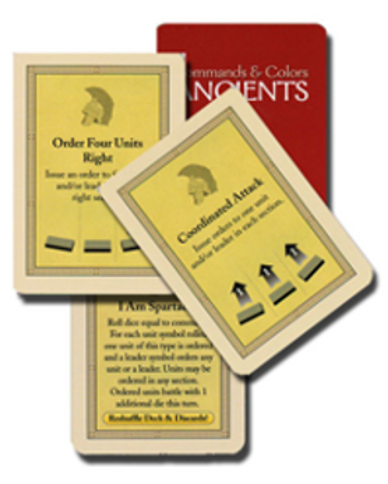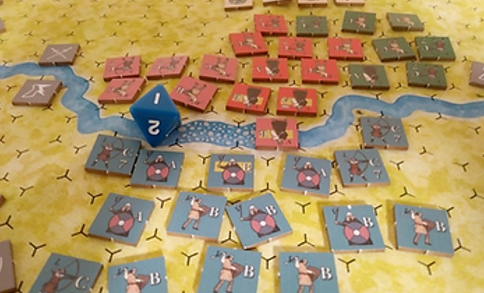Ancient Games: Commands & Colors: Ancients (2006)
The Backdrop
‘Cn. Lentulus, a military tribune, saw the consul covered with blood sitting on a boulder. “Lucius Aemilius,” he said, “the one man whom the gods must hold guiltless of today’s disaster, take this horse while you have still some strength left […] Do not make this day still more dreadful by a adding consul's death, there are enough tears and mourning already.” The consul replied: “Long may you live to do brave deeds, Cornelius. Do not waste the few moments you have to escape from the enemy by pitying me. Go, announce publicly to the Senate that they must fortify Rome and make its defence strong before the victorious enemy approaches [...] Allow me to die among my men; let me not have to defend myself again when I am no longer consul, or appear as the accuser of my colleague and protect my own innocence by throwing the guilt on another.”’ (Livy 22.49.6-11, tr. Roberts, adapted)
This poignant exchange is provided by Livy near the end of his account of one of Rome’s most catastrophic military defeats: the Battle of Cannae (216 BCE).
The Second Punic War (218-201 BCE) was the second of three conflicts between Rome and Carthage for dominance in the Mediterranean. The war began in Spain, with the Carthaginian assault on Saguntum (how far this was provoked by Roman activity is debated). The war would soon to arrive in Italy: Hannibal achieved the almost miraculous task of marching his army across the Alps to invade from the north.
Once in Italy, Hannibal defeated Roman forces in quick succession at Trebia (218) and Lake Trasimene (217). In the months following, a panicked Senate appointed Fabius Maximus as temporary dictator, conferring emergency powers onto him in the hope of setting Rome back on an even keel. His preferred strategy was to deny Hannibal pitched battle, attacking his supply lines, and engaging in a guerrilla campaign: the Fabian strategy. This furtive style of warfare proved unpopular, however, with those seeking vengeance and a swift resolution.
As 216 commenced, the consulship passed to Lucius Aemilius Paullus and Gaius Terentius Varro. Preparations began to take the fight to Hannibal. The consuls jointly led a host of unprecedented size, potentially 80,000 men (although such figures are often unreliable). They did not have to wait long to find their enemy, with Hannibal moving to capture the strategic citadel at Cannae in Apulia. Despite rising tension between the two consuls (whose command of the army switched daily), the Romans prepared to attack.
Commanded by the impetuous Varro, the Roman infantry surged forward en masse, attempting to punch a hole in Hannibal’s line. The Carthaginian commander, however, allowed the troops at his centre to fall back, while his stronger troops on the wings enveloped the Romans in a pincer movement. The result was slaughter.
Cannae was a shattering defeat, causing terror in Rome and prompting erstwhile allies to defect. Despite this catastrophic loss, however, the Republic clung on. Over the course of the next decade, Roman forces successfully repulsed Hannibal from Italy, eventually forcing the Carthaginians from the Iberian Peninsula and achieving final victory in North Africa in 202.
The Punic Wars have long captured the popular imagination. Understandably, given his Alpine exploits, much of this attention has focused on Hannibal: he is immortalised in film, music, and even on the Tunisian 5 dinar note. The Punic Wars more generally, however, have proven fertile ground for game developers. Today’s offering is part of a series of titles that are, for many, a bridge between the boardgaming and wargaming worlds: Commands and Colors: Ancients.
Tunisian banknote depicting Hannibal
The Game
Players: 2 Duration: 60-90mins
Age: 12+ Publisher: GMT Games
Commands and Colors is a set of wargames produced by GMT, utilising a ruleset developed by Richard Borg. A variety of settings have inspired games in this series, from Feudal Japan to the American Civil War. One of the most popular settings in this franchise is the world of antiquity. At its fullest extent, this incarnation of the game offers players the chance to fight clashes from the Greco-Persian wars through to Roman battles of the third century CE. The core box of the Ancients series, however, focuses heavily on the Punic Wars, with particular attention on the Hannibalic campaign.
So how do you play Commands and Colors: Ancients?
Players take on the roles of opposing commanders at significant battles of the era. A central board represents the battlefield and is comprised of a series of hexes. Depending on the scenario, a variety of terrain tiles are placed down (hills, rivers, forests etc.), each affecting play differently.
The armies themselves consist of wooden blocks with different icons to distinguish between troop types. While on initial inspection the array of images might seem puzzling, closer examination reveals that troops can be divided into straightforward categories (infantry, cavalry, ‘special’ and commanders) and that they can be classed as either ‘light’, ‘medium’ or ‘heavy’.
Before commencing, players agree upon the scenario they would like play (it is customary to play the game twice in one sitting, playing the same battle from both perspectives). Once this has been agreed, a scenario booklet provides full instructions for setup, describing the victory conditions and offering a historical background to the battle.
Players then take turns to activate units, attempting to meet the victory conditions for that scenario. This will usually comprise of destroying enemy units or seizing and holding key locations on the battlefield. When a unit is activated, it may move and attack if possible. When this occurs, the attacking player rolls dice equal to the unit’s ‘attack value’. Rather than ordinary dice, these are marked with symbols specific to the game. Three sides correspond to the light, medium and heavy classifications. Hits are scored by matching the symbol of the target unit and result in one block being removed from play with each success. There are also three more situational icons. The first depicts a pair of crossed swords. This essentially functions as a ‘wild’ icon for certain units. Another possible outcome is a white flag: this denotes that the target unit has been forced to retreat. In this eventuality, the target unit must withdraw the full extent of its movement value; if the unit cannot complete this move (owing to other units blocking their path for example) they lose one strength for each point of movement outstanding. The final die face depicts a Roman helmet. This icon counts as a hit if there is a commander attached to the attacking unit.
How do you decide which units are activated on any given turn, though?
This is where Commands and Colors stands out from other wargames. In addition to the board comprising of hexes, the battlefield is divided into three sections, meaning that players will each have a centre ground, left and right flanks. At the start of each battle, players will draw a hand of cards as dictated by the setup instructions. This is their ‘command deck,’ and is how they convey orders to their army. Upon these cards will usually be printed an instruction allowing the player to activate between one and three units in one of the three board sectors, with some more advanced cards allowing more complex moves. The difficulty for the players, however, is that they are only ever allowed to play one card per turn and have no idea what orders they will subsequently draw. This means that on each and every turn, players face a conundrum: will they be able to prevent the enemy advancing on their flank? Will they have the cards to maintain a successful offensive? Will they be able to get their reserves to the frontline in time? Through a simple deck of cards, the fog of war is replicated surprisingly effectively.
The Review
When I was a teenager, I was obsessed with games published by Games Workshop. Whether it was Warhammer Fantasy, ‘40K’ or Necromunda, these were the benchmark against which I judged all table-top wargames. If you had told me then that I would be playing an historical wargame in which the movements were decided by cards and only a handful of dice, I’d have thought you were mad: wargames had to be massive, bloated, and complete with a bucket of dice and a Byzantine codex of rules! While miniature-based games still occupy a fond place in my heart, I have also become much keener on simpler games that I can ‘pick up and play,’ as I’ve gotten older.
Starting with the aesthetics of the game, the artwork is rendered in quite a simplistic style on both the box and components. This might be a bit too cartoonish to some, but I think it treads a fine line of being detailed enough while remaining comprehensible in play. The main problem I have with the aesthetic is that the images associated with each troop type are generic. I can’t help feel taken out of the game somewhat when I see that my early republican allies appear identical to my early imperial auxilia… Perhaps that’s a niche critique from a classicist, though.
A more practical criticism is that the game is supplied with bare wooden blocks and sheets of stickers: you must apply all the unit icons yourself! Stickering can take a long time – so much so that my wife and I would usually spend an evening with a bottle of wine and a film while doing it! This is a quite a significant mark against Commands and Colors: Ancients for me. The game is not cheap. It cannot have cost the publisher all that much to provide the components pre-prepared.
On the subject of wooden blocks, however: once stickered, they are one of my favourite elements of the game. While perhaps not antique in atmosphere, there is something delightfully old-school about moving them across the board. For those of a particular generation, it is reminiscent of the Time Commanders TV series! In any event, I feel like I am playing a game far older than its <20 years.
Moving onto gameplay, the system of command and control in Commands and Colors: Ancients is one of my favourite features. Firstly, the grid that covers the board removes all the ambiguity of measuring distance and range that can often lead to disagreements in open-plan wargames. You know exactly where your forces are, where your opponent’s troops are, and how much distance there is between them. Secondly, the card-driven system for troop movement is exciting: keeping the game flowing smoothly and recreating the fog of war in an entertaining fashion. There is something frustrating yet hilarious about planning an attack in your head, getting three quarters of the way through, and then simply running out of the ‘right’ cards! You are left engaging in sub-optimal moves, desperately trying to draw new cards that will help you realise your grand strategy.
On the one hand, you might feel that this renders the game a little too subject to chance. On the other hand, though, I think it’s a pretty effective simulation of the chaos of battle: some attacks will stall unexpectedly; some units, surrounded and isolated, will stand their ground. In any event, this also gives the game a great replay value since, win or lose, you will likely come away thinking that you could have done better if only you’d had the right cards! The dice add to this general feeling of uncertainty. You may crush all before you with a heavy infantry charge or, alternatively, you might find yourself stunned and decimated by a light cavalry counter-attack. This might sound a little too random, but it is offset by giving heavier units more attack dice, meaning that it never feels dull when you suffer an unexpected turnaround: c’est la vie, c’est la guerre!
One question that comes to mind is whether I would be able to use the game as a teaching aid. It does offer something of a simulation (since the armies that you control are never ‘balanced’), but the game is perhaps just a little too abstract to function as a pedagogical tool. While the randomness built into the game makes it entertaining, it reduces the simulation value overall. That, along with the limited player number means that I would likely overlook this game in favour of something driven more by the personalities of the players, such as The Punic War by Philip Sabin, if I was seeking to engage a class with a game about this period.
As a bit of fun, however, I find this one difficult to overlook. It’s sleek and yet feels old; it’s easy to learn but rarely feels predictable. Beyond history and military buffs, this is a wargame for people who aren’t wargamers! So, what are you waiting for? Don your lorica hamata, saddle up and fight for the honour of Carthage or Rome!


